You've got your cross-trainers but you still haven't got the will to get pumpin' this weekend. What may be stopping you are some dead-beat ideas about how to lose weight and stay fit. We let you in the real deal behind 10 commonest exercise myths!
Dr Michael Chia
Assistant Professor
School of Physical Education
NIE, NTU
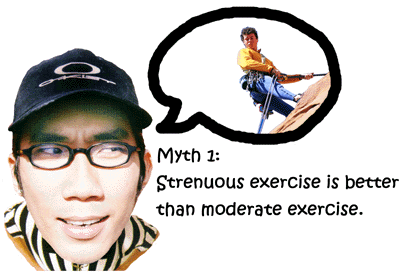
Strenuous workouts are best reserved for athletes who wish to improve their sporting performance,and they do not necessarily translate into a great health advantage. On the contrary, strenuous workouts to the novice weekend warrior (be honest!) can be a potential source of injury and so may do more harm than good. The key is to exercise at a level that is appropriate to your current level of fitness and progress from there.
Research shows that the death rates from heart disease, cancer, and diabetes are much lower in people who exercise at a moderate intensity compared to non-exercisers; but they are only marginally lower in people who exercise strenuously.
Moreover, 'moderate exercisers' have a less adverse response to stress and anxiety and also have lower blood pressure at rest and during exercise, the same benefits as 'strenuous exercisers'. Moderate exercise like walking is just as effective, if not more effective, as a weight management tool. The number of calories expended during exercise depends mainly on how much ground is covered and not how fast you cover it. Moderate exercise is more manageable than vigorous exercise for most people, so you are more likely to keep at it.
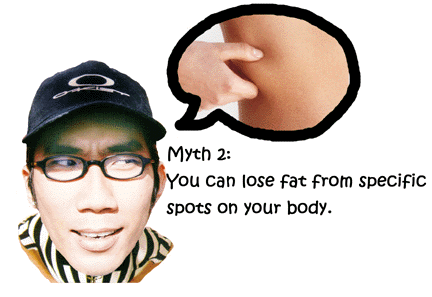
'Spot reduction' is just bunk. When you exercise, you use energy produced by fat from all parts of your body, not just around the muscles that are doing most of the work. In fact your genes may dictate that fat disappears from say, your face or arms before your belly, even when you do endless ab exercises. However, exercising a specific region such as the abdominal muscles will strengthen those muscles. The muscles will help you hold your gut in, and give the illusion that you look thinner!
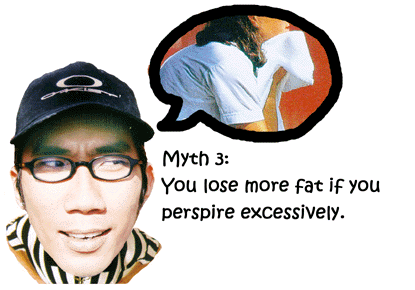
Sweating is the body's attempt at cooling the body because of a rise in body temperature that is brought on by the increase in physical activity. In humid weather, you may feel that you are sweating more but that is because moist air slows down the evaporation of sweat. The use of rubber or non- porous attire during exercise or the use or special thermal warps may cause you to sweat even more than usual and result in weight loss immediately after the session. However this loss in weight is mainly 'water weight', and will be replenished once you drink water. Don't exercise just to lose water. Dehydration can to heat strain, heat exhaustion or even heat stroke.
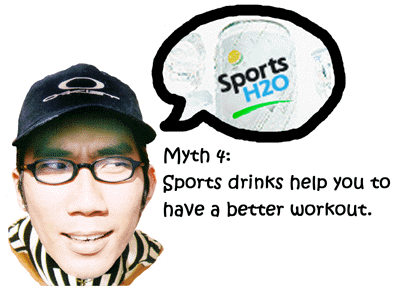
Sugar and sodium are the two main ingredients in sports drinks that are potentially beneficial to exercisers. Sodium helps the body to retain water and sugar, a carbohydrate, provides the body with energy.
But the fact is very few people exercise long enough to sweat away much sodium or use up their carbohydrate reserve (in the form of muscle and liver glycogen) to require any special supplementation. In fact supplementation is not necessary for a workout that lasts less than 90 minutes. Water is all that is needed.
As a rule of thumb, drink about 300 of mildly flavoured (with salt and sugar to help people drink more) or plain water before exercise followed by a cupful (about 100ml) every 15 to 20 minutes thereafter. Drink again after the exercise.
Make sure to drink enough to make you weigh the same a few hours after the workout as you did before the workout. This is especially true among young and old people when they exercise.
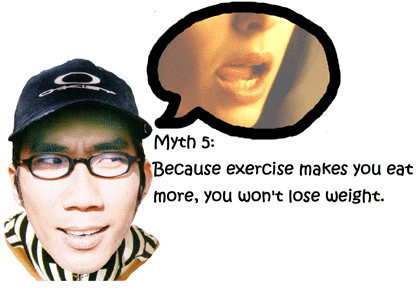
Aerobic-type exercise such as jogging or brisk walking may indeed increase your appetite - but only it seems in people who need the extra calories. Studies have shown that lean individuals do get hungrier after such exercise; this helps to keep them from getting too thin. On the other hand, no such effect is observed in obese individuals.
The intensity of the exercise is another factor. In general, light exercise may stimulate appetite, but more vigorous exercise tends to suppress appetite. Even if appetite is stimulated in the short term, it's good to continue exercising. In the long term, working out is an effective weight management and disease-risk reduction strategy.
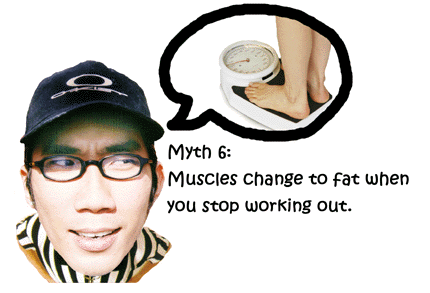
Lack of exercise can cause your muscles to reduce in size. The lack of physical exercise itself reduces the caloric expenditure due to exercise. So people who stop exercising are indeed in danger of becoming flabby. However, that does not mean that muscle actually turns into fat - that is impossible as fat and muscle are different type of tissues. Fat can accumulate around the muscles if you remain inactive. But you can save yourself from that layer of fat by eating a balanced diet and continue with exercise on a regular basis.
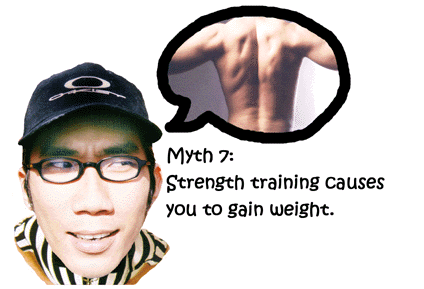
Whether you do light or heavy weights over a sustained period of time, your body continues to burn calories even after you've stopped the weight training session. This effect can go on for several hours, depending on the intensity of the workout.
Research shows that three months of strength training increases the caloric expenditure rate by 7 percent, two kilograms of fat was lost and nearly as much muscle was put on. As muscle tissue is more compact than fat tissue, volunteers in the study felt that they were thinner. More importantly, the subjects lost fat despite an increasing their food intake.
Strength training is especially effective when it is used as part of a comprehensive weight. In another study, it was reported that women who ate a moderately restrictive diet and did either strength-training or aerobic exercise lost more weight than those who only dieted. However, those who split their exercise time between strength training and aerobic exercise obtained the best results.
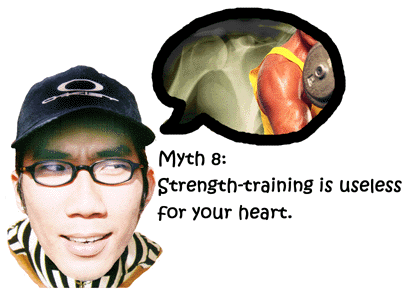
A combination exercise programme that targets the development of strength and aerobic endurance is not only good for managing the waistline but is also good for the heart. Eleven clinical research trials have shown that strength training can reduce LDL cholesterol without any effect on HDL concentrations. A number of other studies have shown that strength training, like aerobic exercise may help reduce blood pressure in people with hypertension. You'll be able to guard against the risk of that sudden unaccustomed exertion, such as moving furniture or pushing a stalled vehicle, which can trigger a heart attack.
However, check with your doctor. If you have hypertension, strength training may temporarily increase your blood pressure because of the strain.
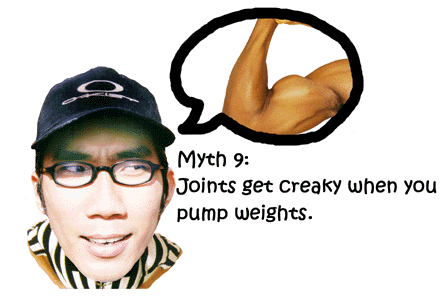
In strength training, the appropriate manner to train is to perform each exercise through the normal range of motion in a controlled manner, and with correct alignment and posture.
Research has shown that joint flexibility remains unchanged, or is improved, if the full range of motion of the exercise is performed. Stretching between each exercise set is also a good routine as that will continue to keep your exercised muscles supple. What's more, you'll help the muscles recover from the exertion.
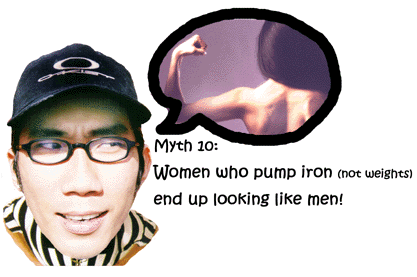
This has to be the most self-defeating myth of all. Both men and women can build firmer muscles by exercising with lighter weights - one where they are able to complete 25 or more repetitions of the exercise.
It is very difficult for women to end up looking big and stocky, because they simply do not have the same amount of the anabolic hormone, testosterone, to build large and bulky muscles.
Rather than worrying about how you'll look, think about the bliss you get once you get into your workout. And that's enough to make you look healthy and fit through another week!
References:
- Sforza, et al (1998), Cardioresistance Exercise: A New Training Technique. ACSM Journal.
- ACSM Position Stand. The recommended quantity and quality of exercise for developing and maintaining cardiovascular and muscular fitness in healthy adults. Medicine and Science in Sports and Exercise, 30 (6): 975-991.
- Michael Chia (2000), Thermoregulation in Young People: Implications for the PE teacher, Sports trainer and Activity Organiser. Teaching & Learning Journal (in press)
- Annual Editions. Health 98/99. McGraw-Hill.
- Wilmore, J & Costill, D (1999). Physiology of Sport & Exercise. Human Kinetics.
Date reviewed: 21 March 2005